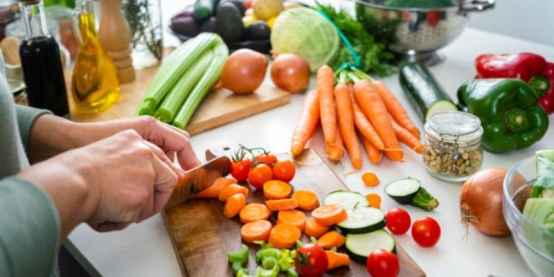How To Meal Prep For A Week On Just $50 (With Recipes & Shopping List)
Rising food prices make it more complicated than ever to eat well without breaking the bank. Many people turn to takeout or packaged meals when stressed, but this only drains their wallets faster.
Meal prepping on a $50 weekly budget might be the ultimate solution—it saves money, reduces daily decision fatigue, and makes eating healthy less stressful. This guide breaks down every step, from shopping to recipes, making it realistic for anyone to follow.
How Far Can $50 Go for Weekly Meals?
When stretched wisely, fifty dollars can cover an entire week of balanced meals.
For one person (3 meals per day): $50 allows variety without skimping on nutrition.
For two people: Slight substitutions and bulk adjustments still keep the total affordable.

Assumptions: This plan assumes access to basic pantry staples like oil, salt, and spices. Starting from scratch would require a slightly bigger initial investment.
On average, each meal can be kept between $1.50 and $2.00—a fraction of what dining out costs.
Budget Shopping Strategy
The foundation of affordable meal prep is smart grocery shopping. Where and how you shop make all the difference.
Shop at Affordable Stores: Discount grocers like Aldi, Walmart, and local markets often undercut premium chains.
Seasonal & Frozen Produce: Seasonal fruits and vegetables are cheaper and fresher. Frozen vegetables are cost-effective and reduce waste.
Bulk Proteins: Purchasing chicken, dried beans, and eggs in larger packs allows them to be used across multiple meals.
Store Brands Over Name Brands: Store-labelled items often match big brands in quality for less.
Avoid Red-Flag Spenders: Pre-packaged snacks, bottled drinks, and speciality ingredients quickly push a budget past target.
For additional insights, the USDA grocery cost report shows how families can manage food on varying budgets.
$50 Meal Prep Shopping List (with Costs)
Here’s a realistic sample shopping list, prices averaged across discount chains:
Proteins
Chicken thighs (5 lb) – $10
Eggs (dozen) – $2.50
Lentils (2 lb) – $3
Canned tuna (3 cans) – $3
Carbs/Starches
Rice (5 lb) – $4
Oats (2 lb) – $3
Whole grain pasta (2 lb) – $3.50
Vegetables/Fruits
Frozen mixed vegetables (2 bags) – $5
Fresh bananas (7 count) – $2.50
Apples (3 lb) – $4
Carrots (2 lb) – $2
Extras/Condiments
Peanut butter – $3.50
Canned tomatoes (2 cans) – $2
Popcorn kernels (1 lb) – $2
Flexibility is key: swap chicken for tofu, rice for potatoes, or apples for oranges, depending on store sales.

7-Day Meal Plan Breakdown
A simple structure makes meal prepping seamless:
Breakfast: Oats with peanut butter and bananas
Lunch: Chicken rice bowls with mixed vegetables
Dinner: Lentil chilli with cornbread or whole grain pasta
Snacks: Apple slices, carrots, or homemade popcorn
By rotating slight variations, meals feel fresh while staying on budget.
Batch Cooking & Prep Guide
A focused 2–3 hour Sunday prep session ensures the week runs smoothly:
Cook a bulk pot of rice and beans.
Roast trays of seasoned chicken and vegetables.
Pre-portion overnight oats in individual containers.
Store meals strategically: fresh in the fridge for early-week, freezer-bound for later.
Reusable glass or BPA-free plastic containers help in portioning and cut future costs. Harvard School of Public Health also emphasises balanced preparation for long-term health.
Recipes Under $2 per Serving
Breakfast Options
5-minute oats with peanut butter and banana
Freezer-friendly breakfast burritos with scrambled eggs and veggies
Lunch/Dinner Options
Lentil chilli (hearty, high in fibre)
Chicken stir-fry with frozen veggies
Pasta bake with canned tomatoes and roasted vegetables
Snack Options
Stovetop popcorn with light seasoning
DIY trail mix with peanuts and raisins
Carrot sticks with homemade hummus
Cost Per Meal Breakdown
Examples of cost per Serving:
Overnight oats: $0.80
Lentil chili: $1.20
Chicken stir-fry: $1.90
This breakdown proves affordability without compromising nutrition.
Tips to Stretch the Budget Further
Stretching $50 is about reducing waste and maximising meals:
Repurpose leftovers creatively—chillichilli becomes chillichilli mac, and chicken turns into wraps.
Freeze portions immediately to avoid spoilage.
Use seasonings like garlic powder, paprika, or soy sauce to bring variety affordably.
Adjust easily when prices rise—swap proteins and consider dried beans.
The Cleveland Clinic also highlights how batch cooking protects both health and budget.
Meal Prep Variations for Different Needs
Family Version: Scaling up proportions makes $50 per person possible.
Vegetarian/Vegan: Replace chicken with tofu, eggs with beans or lentils.
High-Protein: Add cottage cheese or Greek yoghurt if affordable.
Gluten-Free: Substitute pasta for rice or corn-based alternatives.

Common Budget Meal Prep Mistakes to Avoid
Buying too much fresh produce without freezing it is a common mistake.
Overcomplicating recipes adds unnecessary costs.
Ignoring portion sizes leads to midweek shortages.
Forgetting to budget for snacks and beverages.
Getting Started with Affordable Meal Prep
Staying under $50 per week for meal prep is more than possible; it's practical. With smart shopping, weekly planning, and simple recipes, eating well doesn't have to be expensive. This approach saves money, reduces daily Stress, and ensures balanced nutrition—all while keeping meals enjoyable.
Sources
Related Posts

5 Super Easy Muffin Pan Dessert Recipes

The Ultimate Guide To The Ketogenic Diet For Beginners

Super Bowl Party Appetisers: The Ultimate Game Day Guide

Moroccan Tagine Recipes For Beginners: Easy, Authentic, And Flavorful Dishes

The Ultimate Guide To No-Cook Camping Meals: Simple, Nutritious, And Fire-Free
